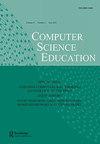Communicating about computational thinking: understanding affordances of portfolios for assessing high school students’ computational thinking and participation practices
IF 2.2
Q1 EDUCATION & EDUCATIONAL RESEARCH
引用次数: 7
Abstract
ABSTRACT Background and Context: While assessment of computational thinking concepts, practices, and perspectives is at the forefront of K-12 CS education, supporting student communication about computation has received relatively little attention. Objective: To examine the usability of process-based portfolios for capturing students’ communication about their computational practices regarding the process of making electronic textile projects. Method: We examined the portfolios of 248 high school students in 15 introductory CS classrooms from largely underserved communities, using a formal rubric (top-down) to code computational communication and an open-coding scheme (bottom-up) to identify computational practices described. Findings: Students demonstrated stronger abilities to communicate about computation using text than visuals. They also reported under-assessed CT practices like debugging, iterating, and collaborating. Students of experienced e-textile teachers performed substantially better than those with novice e-textile teachers. Implications: Portfolios provide a viable addition to traditional performance or survey assessments and meet a need to promote communication skills.关于计算思维的交流:理解档案袋对评估高中生计算思维和参与实践的可供性
摘要背景和背景:虽然对计算思维概念、实践和观点的评估是K-12 CS教育的前沿,但支持学生关于计算的交流却相对较少受到关注。目的:检验基于过程的档案袋的可用性,以捕捉学生在电子纺织品项目制作过程中的计算实践交流。方法:我们检查了来自服务不足社区的15个CS入门教室中的248名高中生的档案,使用正式的量规(自上而下)对计算通信进行编码,并使用开放编码方案(自下而上)来识别所描述的计算实践。研究结果:与视觉效果相比,学生们在使用文本进行计算交流方面表现出更强的能力。他们还报告了未充分评估的CT实践,如调试、迭代和协作。经验丰富的电子教材教师的学生表现明显好于新手电子教材教师。影响:投资组合为传统的绩效或调查评估提供了一个可行的补充,并满足了提高沟通技能的需求。
本文章由计算机程序翻译,如有差异,请以英文原文为准。
求助全文
约1分钟内获得全文
求助全文
来源期刊

Computer Science Education
EDUCATION & EDUCATIONAL RESEARCH-
CiteScore
6.90
自引率
3.70%
发文量
23
期刊介绍:
Computer Science Education publishes high-quality papers with a specific focus on teaching and learning within the computing discipline. The journal seeks novel contributions that are accessible and of interest to researchers and practitioners alike. We invite work with learners of all ages and across both classroom and out-of-classroom learning contexts.
 求助内容:
求助内容: 应助结果提醒方式:
应助结果提醒方式:


